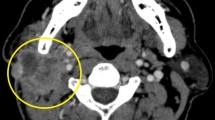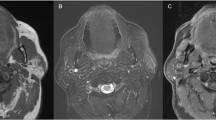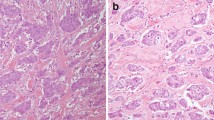Abstract
Salivary duct carcinoma (SDC) is a highly aggressive malignancy of the salivary glands. However, one type of SDC, which shows minimal invasion and better prognosis, is known as low-grade SDC (LG-SDC). This report presents an additional case of LG-SDC of the parotid gland. The patient was a 38-year-old Japanese woman who noticed painless swelling of the left parotid region. Grossly, the cut surface of the tumor was cystic. Microscopically, the tumor showed a multicystic pattern, which was lined by eosinophilic to clear atypical cells with cribriform or Roman bridge patterns. An immunohistochemical examination revealed the tumor was positive for cytokeratin (CK) 7 and epithelial membrane antigen, partially positive for androgen receptor and gross cystic disease fluid protein-15, and diffusely positive for Her-2/Neu, progesterone, and estrogen receptors. The cancer cells showed focal immunopositivity for S-100 protein. Immunostaining for p63, CK14, and calponin showed an in situ pattern in most areas of this tumor, whereas the tumor showed minimal invasion. The cancer cells were diffusely positive for MUC1 and MUC6 and focally positive for MUC2 and MUC4. Finally, the tumor was diagnosed to be LG-SDC. The differential diagnosis and the mucin pattern were evaluated.
Similar content being viewed by others
References
Lewis JE, McKinney BC, Weiland IH, Ferreiro JA, Olsen KD (1996) Salivary duct carcinoma: clinicopathologic and immunohistochemical review of 26 cases. Cancer (Phila) 77:223–230
Hellquist HB, Karlsson MG, Nilsson C (1994) Salivary duct carcinoma: a highly aggressive salivary gland tumor with overexpression of C-erbB-2. J Pathol 172:35–44
Delgado R, Vuitch F, Albores-Saavedra J (1993) Salivary duct carcinoma. Cancer (Phila) 72:1503–1512
Brandwein-Gensler MS, Skalova A, Nagao T (2005) Salivary duct carcinoma. In: Barnes L, Eveson JW, Reichart P, Sidransky D (eds) World Health Organization classification of tumours: pathology and genetics. Head and neck tumours. IARC Press, Lyon, pp 236–237
Delgado R, Klimstra D, Albores-Saavedra J (1996) Low grade salivary duct carcinomas: a distinctive variation with a low grade histology and a predominant intraductal growth pattern. Cancer (Phila) 78:958–967
Brandwein-Gensler M, Hille J, Wang BY, Urken M, Gordon R, Wang LJ, Simpson JRM, Simpson RHW, Gnepp DR (2004) Lowgrade salivary duct carcinoma: description of 16 cases. Am J Surg Pathol 28:1040–1044
Brandwein-Gensler M, Gnepp DR (2005) Low-grade cribriform cystadenocarcinoma. In: Barnes L, Eveson JW, Reichart P, Sidransky D (eds) World Health Organization classification of tumours: pathology and genetics. Head and neck tumours. IARC Press, Lyon, p 233
Weinreb I, Tabanda-Lichauco R, Van der Kwast T, Perez-Ordonez B (2006) Low-grade intraductal carcinoma of salivary gland: report of 3 cases with marked apocrine differentiation. Am J Surg Pathol 30:1014–1021
Cheuk W, Miliauskas JR, Chan JKC (2004) Intraductal carcinoma of the oral cavity. A case report and a reappraisal of the concept of pure ductal carcinoma in situ in salivary duct carcinoma. Am J Surg Pathol 28:266–270
Simpson RH, Desai S, Di Palma S (2008) Salivary duct carcinoma in situ of the parotid gland. Histopathology (Oxf) 53:416–425
Kusafuka K, Bando E, Muramatsu K, Ito H, Tanizawa Y, Kawamura T, Mocizuki T, Terashima M, Nakajima T (2009) Pancreatic-type mixed acinar-endocrine carcinoma with alpha-fetoprotein production arising from the stomach: a report of an extremely rare case. Med Mol Morphol 42:167–174
Anderson C, Muller R, Piorkowski R, Knibbs DR, Vignoti P (1992) Intraductal carcinoma of major salivary gland. Cancer (Phila) 69: 609–614
Barnes L, Rao U, Krause J, Cortis L, Schwartz A, Scalamogna P (1994) Salivary duct carcinoma: Part I. A clinicopathologic evaluation and DNA image analysis of 13 cases with review of the literature. Oral Surg Oral Med Oral Pathol 78:64–73
Barnes L, Rao U, Contis L, Krause J, Schwartz A, Scalamogna P (1994) Salivary duct carcinoma. Part II. Immunohistochemical evaluation of 13 cases for estrogen and progesterone receptors, cathepsin D, and c-erbB-2 protein. Oral Surg Oral Med Oral Pathol 78:74–80
Brandwein MS, Jagirdar J, Patil J, Biller H, Kaneko M (1990) Salivary duct carcinoma (cribriform salivary carcinoma of excretory ducts): a clinicopathologic and immunohistochemical study of 12 cases. Cancer (Phila) 65:2307–2314
Skalova A, Starek I, Kucerova V, Szepe P, Plank L (2001) Salivary duct carcinoma: a highly aggressive salivary gland tumor with HER-2/neu oncoprotein overexpression. Pathol Res Pract 197:621–626
Nasser S, Faquin WC, Dayal Y (2003) Expression of androgen, estrogen, and progesterone receptors in salivary gland tumors. Frequent expression of androgen receptor in a subset of malignant salivary gland tumors. Am J Clin Pathol 119:801–806
Williams MD, Roberts D, Blumenschein GR Jr, Temam S, Kies MS, Rosenthal DI, Weber RS, El-Naggar AK (2007) Differential expression of hormonal and growth factor receptors in salivary duct carcinomas. Biologic significance and potential role in therapeutic stratification of patients. Am J Surg Pathol 31:1645–1652
de Bolos C, Guma M, Barranco C, Garrido M, Kim YS, Real FX (1998) MUC6 expression in breast tissues and cultured cells: abnormal expression in tumors and regulation by steroid hormones. Int J Cancer 77:193–199
Alos, L, Lujan B, Castillo M, Nadal A, Carreras M, Caballero M, de Bolos C, Cardesa A (2005) Expression of membrane-bound mucins (MUC1 and MUC4) and secreted mucins (MUC2, MUC5AC, MUC5B, MUC6 and MUC7) in mucoepidermoid carcinomas of salivary glands. Am J Surg Pathol 29:806–813
Simpson RH, Prasad AR, Lewis JE, Skalova A, David L (2003) Mucin-rich variant of salivary duct carcinoma: a clinicopathological and immunohistochemical study of four cases. Am J Surg Pathol 27:1070–1079
Foss RD, Ellis GL, Auclair PL (1996) Salivary gland cystadenocarcinomas: a clinicopathologic study of 57 cases. Am J Surg Pathol 20:1440–1447
Ellis GL, Auclair GL (1995) Mucoepidermoid carcinoma. In: Ellis GL, Auclair PL (eds) Atlas of tumor pathology, third series. Fascicle 17. Tumors of the salivary glands. Armed Forces Institute of Pathology, Washington, DC, pp 155–175
Author information
Authors and Affiliations
Corresponding author
Rights and permissions
About this article
Cite this article
Kusafuka, K., Itoh, H., Sugiyama, C. et al. Low-grade salivary duct carcinoma of the parotid gland: report of a case with immunohistochemical analysis. Med Mol Morphol 43, 178–184 (2010). https://doi.org/10.1007/s00795-009-0479-2
Received:
Accepted:
Published:
Issue Date:
DOI: https://doi.org/10.1007/s00795-009-0479-2




